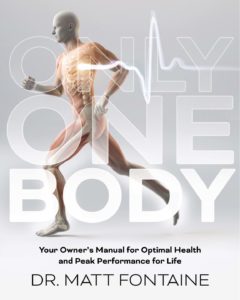21 May Proper Sequencing of Exercise Selection
By Dr. Matt Fontaine This is another article in the series on Secrets to Resolving Muscle and Joint Pain Syndromes. This one focuses on the proper sequence for implementing rehab exercises and the rational behind it. The main premise is that rehab is often too top heavy on strengthening right from the beginning of treatment. It is imperative that we first address tight, restricted soft tissues, improve range of motion, and improve motor patterns before we begin strengthening exercises. Pain-free functional movement for participation in occupation and lifestyle activities is desirable. Many components comprise pain-free functional movement including adequate posture, ROM, muscle performance, motor control, and balance reactions. Impairments of each component could potentially alter functional movement resulting in or as a consequence of pain. Normal movement is achieved through the integration of fundamental movement patterns with an adequate balance of mobility and stability to meet the demands of the task at hand. The human system will migrate toward predictable patterns of movement in response to pain or in the presence of weakness, tightness, or structural abnormality. Over time, these pain attenuated movement patterns lead to protective movement and fear of movement, resulting in clinically observed impairments such as decreased ROM, muscle length changes, and declines in strength. An isolated or regional approach to either evaluation or treatment will not restore the whole of function. Functional restoration requires a map of dysfunctional patterns and a working knowledge of functional patterns to gain clinical perspective and design an effective treatment strategy. Functional restoration of normal movement patterns will be achieved through the integration of corrective exercise integrating fundamental movement patterns with an adequate balance of mobility and stability to meet the demands of functioning in occupation and lifestyle activities as needed and desired. PHASES OF REHABILITATION 1. Acute Phase: after acute injury like a sprain/ strain to a ligament or muscle, the goals of therapy are to reduce pain, inflammation and edema. Rest, Ice, Compression, Elevation and anti-inflammatories are essential in this phase. 2. Recovery Phase: Improving ROM, increasing neuromuscular control and regaining normal arthrokinematics. 3. Functional Phase: Increase strength and power and neuromuscular control in multiplanar motion utilizing sport-specific training for a full return to sport. Injuries are governed by the laws of physics and controlled by functional anatomy. To properly address the repetitive stressed overactive muscles(synergists), weak prime movers, muscle imbalance and faulty movement patterns, we must first start with a Functional Movement Screen™ or Selective Functional Movement Assessment™. Once we evaluate the condition for movements and note painful vs. nonpainful movements with or without the presence of pain we can then move forward to address limitations in joint motion, muscle imbalance etc. Soft tissue treatments such as Active Release Techniques that utilize motion during treatment are effective at releasing scar tissue within the muscle and restoring gliding between fascial layers, allowing muscles to glide like silk on silk. Once we begin to address these limitations we can then progress to a multi-faceted approach to functional rehab which must be done in a specific order to achieve the best results. The deep underlying issue with faulty movement and is muscle imbalance, poor joint mechanics where the body has “learned how to compensate to avoid pain” and in the process has been programmed to move incorrectly. The basic issue is a neural one. Basically the prime movers are not receiving proper neural input and have become inactive. The plan is as follows and should be done before each training session: 1. Inhibit overactive areas(foam rollers) 2. Lengthen antagonists(Active Release Techniques/ Movement Prep Dynamic Stretching/PNF stretching/ reciprocal inhibition) 3. Activate the inhibited muscle using non weight bearing, low load exercises) 4. Integrate(progress to more functional movement patterns) 5. Reinforce with functional training. The specific order listed above ensures that we address certain issues first:
- First thing first, address tight muscles and stiff joints before we progress to strengthening exercises. Force = Work X Distance. If a muscle is tight, short, and contracted, it must first be lengthened for it to have optimal contraction- relax coupling. Janda refers to these muscles as tonic and they are prone to tightening. This simply means a muscle capable of lengthening properly will contract better and stronger than a short muscle. A short muscle is always a weak muscle, and therefore needs lengthening.
- Using foam rollers and movement prep stretching for muscles after treatments like Active Release Techniques® and joint manipulation helps to improve upon and maintain good muscle lengthening and joint range of motion.
- Once these issues are addressed, we can then properly implement activation exercises which “retrain” the nervous system to wake up sluggish muscles that have been inactive or underactive for a long time. These are usually postural muscles that help to stabilize joints during movement. Janda refers to these muscles as phasic and they tend to be prone to weakness. Once this is addressed, we can then begin to move to impliment functional strength training.
Long Term Functional Goals: 1. Corrective exercise are needed to restore natural functional movement patterns, to address mobility/stability issues, prevent joint and soft tissue dysfunction and prevent joint degeneration and disability. 2. By restoring these normal movement patterns we can establish and foster the patient’s ability to meet the demands of functioning in occupation and lifestyle activities as needed and desired. 3. The cycle of repetitive stressed overactive synergists, weak prime movers, ensuing muscle imbalance and faulty movement is due in part to neural dysfunction. Basically the prime movers are not receiving proper neural input and have become inactive. A proper sequence of rehab strategies must be followed as listed below. The plan is as follows and should be done before each training session: 1. Inhibit overactive areas(foam rollers) 2. Lengthen antagonists(ART/ PNF stretching/ reciprocal inhibition) 3. Activate the inhibited muscle using non weight bearing, low load exercises) 4. Integrate(progress to more functional movement patterns) 5. Reinforce normal movement with functional strength training.




